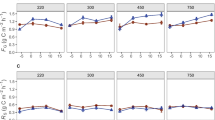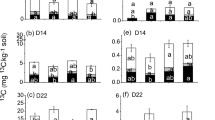Abstract
Biomass production was analysed in Festuca vivipara, grown for 3 months in pots with non-sterilized or sterilized soil after factorial addition of three levels of labile carbon combined with high and low levels of N and P. The soil was a nutrient-poor subarctic heath soil. In the non-sterilized soil plant biomass production increased strongly only in the treatment with high levels of both N and P, which suggests that both nutrients limited plant growth. In the sterilized soil addition of a high level of N without P addition gave almost the same growth response as in the combined NP treatment. This was because of a more than 30-fold increase of inorganic phosphorus in the soil as P was released from the killed microbial biomass after sterilization. Sugar addition reduced plant growth in all treatments. The reduction in plant growth was dose dependent within the range of 0–450 μg C g−1 soil added to the non-sterilized soil, but the response levelled off at 233 μg C g−1 soil in the soil that had been sterilized at the start of the experiment. The plant response, together with observed depletion of soil inorganic N and P, indicated that the microbial biomass immobilized nutrients efficiently and reduced plant growth when extra labile carbon was added. The inhibition of growth was lower, however, in the soil which had been sterilized, probably because of a slow recovery of the microbial populations in it. Two of the nutrient-carbon solutions closely matched the N, P and C concentrations in a solution containing leaf extracts of Cassiope tetragona and Betula tortuosa that had been used previously to test for possible allelopathic effects of compounds in the leaf extracts. These extracts also reduced plant growth. The growth reduction was equally large or larger after nutrient-sugar addition than after addition of leaf extracts in three out of the four possible combinations of species and sterilized or non-sterilized soil. In the fourth case (Betula extract added to sterilized soil), the effect was larger when leaf extract was added than after addition of the nutrient-carbon solution. This could be due to a low rate of microbial degradation of phytotoxic substances in this soil because of a slow recovery of the microbial populations after sterilization. The generally stronger or equal effect of the nutrient-sugar addition compared to the leaf extract addition leads to the conclusion that microbial nutrient immobilization and microbial competition for nutrients increased as a function of labile carbon addition with the extract. Hence, it appears that enhanced microbial activity and microbial nutrient immobilization rather than phytotoxic effects was the primary reasons for the reduced biomass production in F. vivipara even after addition of the leaf extracts.
Similar content being viewed by others
Author information
Authors and Affiliations
Additional information
Received: 25 October 1996 / Accepted: 11 June 1997
Rights and permissions
About this article
Cite this article
Schmidt, I., Michelsen, A. & Jonasson, S. Effects on plant production after addition of labile carbon to arctic/alpine soils. Oecologia 112, 305–313 (1997). https://doi.org/10.1007/s004420050313
Issue Date:
DOI: https://doi.org/10.1007/s004420050313




